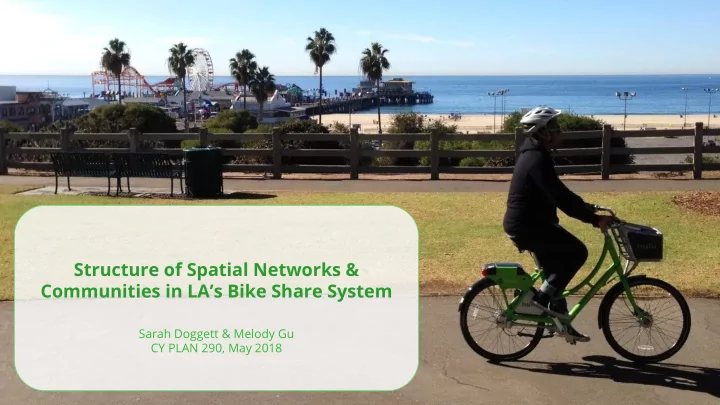

Structure of Spatial Networks & Communities in LA’s Bike Share System Sarah Doggett & Melody Gu CY PLAN 290, May 2018
Purpose ● To evaluate and visualize the Los Angeles Metro Bike Share using spatial and network analysis ● To identify important stations based on use, bicycle flows, and centrality
Zaltz, O’Brien, Strano, & Viana (2013) ● Analysis of bike sharing systems of five cities: ○ London, Boston, Denver, Minneapolis, and Washington DC ● Similarities and differences ● Considers flows of bicycles rather than simply using stand occupation data ○ Move beyond Waldo Tolber’s “first law of geography” ● Visualizations of flows (London)
Methods ● Average degree per network to determine station popularity ● Weighted Eigenvector v. Closeness Centrality ● Modularity for Community Detection ○ Case Studies per Community Data Set ● Trips in Quartile 4 (2017) from October to December, the most recent data available.
Network Properties ● Number of Nodes/Stations: 120 ● Links: 2320 ● Users/Trips: 71,214 Trips made in 2017 Quartile 4. ● Average Degree (k) (directed): 75.35 ● Shortest Longest Path: 2.42
Community Detection ● Community detection: modularity ● We find 6 main communities: Community 1 West LA Community 2 East LA Community 3 Port of LA Community 4 North Port of LA Community 5 Pasadena Community 6 Venice
Overall Network Centrality
Community 1: West Downtown LA TOP 3 STATIONS Degree Centrality Eigenvector Weighted Eigenvector Centrality Centrality 7th & Flower 7th & Flower 7th & Flower 7th & Spring 7th & Spring 7th & Spring Figueroa & 8th Figueroa & 8th 7th & Grand
Community 2: East Downtown LA TOP 3 STATIONS Degree Centrality Eigenvector Weighted Eigenvector Centrality Centrality Traction & Rose Traction & Rose Union Station W Portal Union Station W Portal Union Station W Portal Main & 1st 1st & Judge John AIso 1st & Judge John AIso Traction & Rose
Red = 25 or more trips Downtown LA: Edge Weights Yellow = 10 - 24 trips Green = 5 - 9 trips (by community 1 & 2) Gray = 1 - 4 trips
Community 3: Port of LA TOP 3 STATIONS Degree Centrality Eigenvector Weighted Eigenvector Centrality Centrality Downtown Harbor Downtown Harbor Cabrillo Beach Fanfare Fountain Fanfare Fountain Downtown Harbor Crafted 22nd St Park Crafted 22nd St Park DoubleTree Hotel
Port of LA: Edge Weights (by community 3 & 4) Red = 25 or more trips Yellow = 10 - 24 trips Green = 5 - 9 trips Gray = 1 - 4 trips
Community 4: North Port of LA
Community 5: Pasadena TOP 3 STATIONS Degree Centrality Eigenvector Centrality Weighted Eigenvector Centrality Old Pasadena Old Pasadena Rose Bowl Pasadena Convention Center Pasadena Convention Center Del Mar Station Fair Oaks & Mercantile Alley Fair Oaks & Mercantile Alley Memorial Park Station
Pasadena Edge Weights Red = 25 or more trips Yellow = 10 - 24 trips Green = 5 - 9 trips Gray = 1 - 4 trips
Community 6: Venice TOP 3 STATIONS (All the same!) Degree Centrality Eigenvector Centrality Weighted Eigenvector Centrality Ocean Front Walk & Navy Ocean Front Walk & Navy Ocean Front Walk & Navy Ocean Front Walk & N. Venice Ocean Front Walk & N. Venice Ocean Front Walk & N. Venice Downtown Santa Monica Expo Downtown Santa Monica Expo Downtown Santa Monica Expo Line Station Line Station Line Station
Venice Edge Weights Red = 25 or more trips Yellow = 10 - 24 trips Green = 5 - 9 trips Gray = 1 - 4 trips
Trip Duration Average Trip Duration (min.) Community Weekday Weekend 1 West LA 17 29 2 East LA 18 35 3 Port of LA 38 48 4 North Port of LA 27 33 5 Pasadena 19 35 6 Venice 60 64 Los Angeles 25 41
Conclusion ● Prioritize infrastructure improvements to most connected and most traveled places ● Consider differences in hour of day and weekday/weekend trip behavior ○ This can help with traffic management during high flow periods for both automobiles and bicycles (9AM and 5PM peak) ○ Consider tourism and points of interest for mid-day trips
Recommend
More recommend